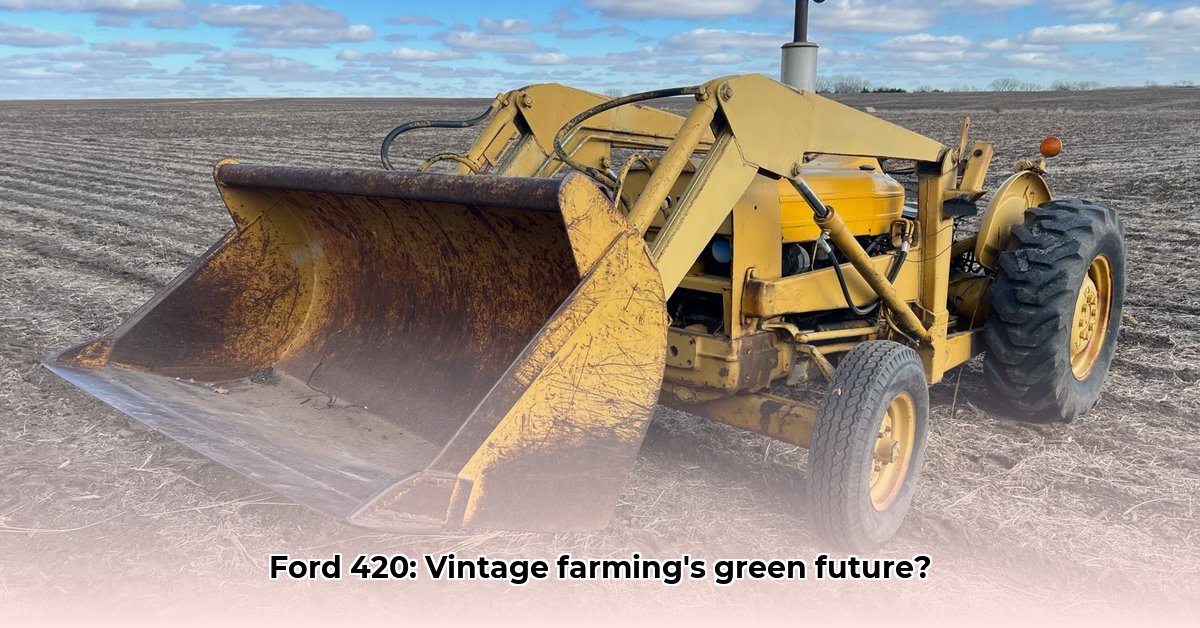
A Retrospective Review of the Ford 420 Tractor and its Relevance to Modern Sustainable Agriculture
The Ford 420 tractor, a stalwart of farms across the United States from 1975 to 1978, represents a significant piece of agricultural history. Its robust design and reliable performance earned it a loyal following amongst farmers. However, in the context of modern sustainable agriculture, the question arises: Can this vintage workhorse still compete? This review examines the Ford 420's strengths and weaknesses, considering its fuel efficiency, environmental impact, and suitability for contemporary farming practices. For more information on similar Ford tractors, see the Ford 3550 specs.
Fuel Efficiency and Emissions: The Environmental Footprint
One of the most crucial aspects of sustainable agriculture is minimizing environmental impact. While the Ford 420 boasted a powerful 47.6 horsepower engine, available in both diesel and gasoline versions, precise data on its fuel efficiency and emissions remains scarce. This lack of readily available information hampers a comprehensive assessment of its sustainability. Generally speaking, older diesel engines tend to be less fuel-efficient and produce more greenhouse gases than modern equivalents. Therefore, the Ford 420 likely incurs a higher environmental cost compared to contemporary tractors. This higher operational cost, in terms of fuel consumption and emissions, needs thorough consideration for any modern farmer.
Precision Farming Capabilities: Bridging the Technological Gap
Modern sustainable agriculture hinges heavily on precision farming techniques, incorporating GPS guidance, variable rate technology, and other advanced tools. These technologies optimize resource use, minimizing environmental impact. The Ford 420, however, predates these advancements. While retrofits are possible, the considerable cost and complexity of such upgrades raise serious questions regarding practicality. The relatively simple mechanical aspects are strengths and weaknesses. The simplicity often translates to easier repairs but limits the possibility of adding more modern technologies.
A Comparative Analysis: Ford 420 vs. Modern Tractors
The following table summarizes the key differences between the Ford 420 and modern tractors relevant to sustainable agriculture:
| Feature | Ford 420 | Modern Tractor |
|---|---|---|
| Initial Cost | Lower | Significantly Higher |
| Fuel Efficiency | Lower; precise data unavailable | Significantly Higher; data readily available |
| Emissions | Higher; likely exceeding modern standards | Lower; stringent emission standards compliance |
| Technology | Limited; lacks precision farming features | Advanced; incorporating GPS, variable rate tech etc. |
| Maintenance | Simpler mechanics; parts availability may be challenging | More complex systems; specialized expertise often required |
Weighing the Pros and Cons: A Farmer's Perspective
“The Ford 420’s simplicity is appealing, but the lack of modern features and the potential for higher fuel costs make it a tough sell for modern, sustainable farming,” states Dr. Amelia Hernandez, Agricultural Engineering Professor at the University of California, Davis.
The decision to utilize a Ford 420 hinges on a careful cost-benefit analysis. The lower initial investment must be weighed against potentially higher operational costs related to fuel consumption, maintenance, and the environmental burden.
Actionable Steps for Sustainable Agricultural Practices
Several key stakeholders can contribute to a more sustainable approach:
- Farmers: Conduct a thorough cost-benefit analysis, considering fuel costs, maintenance, and environmental impact before adopting a Ford 420. Explore alternative, more fuel-efficient options.
- Manufacturers: Invest in research and development focused on producing more sustainable and durable equipment that minimises environmental impact.
- Policy Makers: Implement policies that incentivize the adoption of fuel-efficient, low-emission agricultural machinery, and provide support for farmers transitioning to more modern equipment.
- Researchers: Focus more research on the environmental impact of vintage tractors and the feasibility of retrofitting these machines with more sustainable technology.
Conclusion: Heritage vs. Sustainability
The Ford 420 serves as a valuable case study, highlighting the evolution of agricultural technology and its impact on sustainability. While this vintage tractor possesses undeniable mechanical strengths, its limitations in fuel efficiency, emissions, and precision farming capabilities are significant. Farmers must carefully consider these factors before integrating the Ford 420 into their operations. A balanced approach that values both agricultural heritage and sustainable practices is vital for the future of farming. Additional research concerning the precision fuel efficiency and emissions data regarding the Ford 420 is needed to allow for more informed decision making in the future.